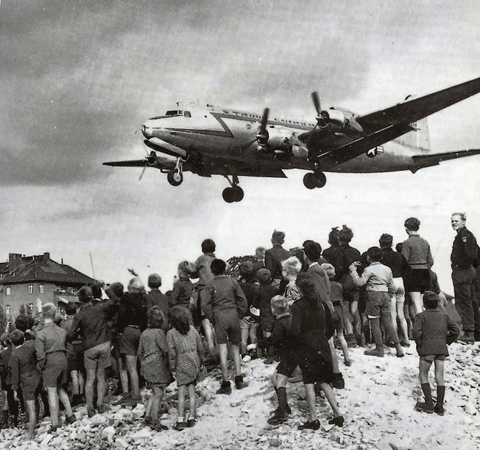Beating the blockade
Once in a while somebody would be in the right place at the right time, and an American soldier would press a piece of fruit into grateful, malnourished hands. For the majority, it was potatoes and soup - and the potatoes had to be cooked at 2am and kept warm in a towel as it was the only time that rationed fuel could be relied upon.
Such was everyday life for West Berliners during the winter of 1948-49. But it could have been much worse if it had not been for the American and British efforts to fly food, coal, medicines and other essential supplies into the allied sectors of Berlin - a city that had been under siege by the Soviets since June 24 1948. The Western powers took the Berlin Blockade seriously - after all, with West Berlin in British, French and American hands the siege was closer to a declaration of war than to mere sabre-rattling and the co-operation of Australian, Canadian, New Zealand and South African air crews reflected the gravity and global nature of the situation; the airlift began on June 26, and western commanders and co-ordinators firmly believed that three weeks would be enough time to negotiate the re-opening of land routes into the city.
In the event, the blockade and airlift continued until well into the next year, officially ending on May 12 1949. During the course of the operation, the allies made around 200,000 successful flights into Berlin. The Americans used the Tempelhof airport in the Tempelhof-Sch?neberg district of the city, for their flights under the code name of Operation Vittles; the British conducted Operation Plainfare via their base at RAF Gatow, which is now home to the Luftwaffe Museum. Both air forces had to use narrow flight paths to enter and leave Berlin to avoid straying into Soviet airspace and risking an escalation from Cold War to full military conflict.

In truth, the blockade and the allied airlift had been almost a foregone conclusion since Germany was carved up after the second world war and the city of Berlin - firmly entrenched in East Germany - was split between America, Britain and France in the west, and the USSR in the east, a border symbolised by the Berlin Wall . Both sides pressed to gain the upper hand between 1945 and 1948, and espionage and diplomatic incidents became commonplace. The spark that ignited this tinderbox city was money. The allies introduced the new Deutschmark to Berlin; the Soviets' Ostmark failed to dominate the currency market and in retaliation Moscow ordered water and power to West Berlin to be cut off, then closed the only authorised allied road and railway into the city. The people of West Berlin had their Deutschmarks, but they were useless in a city which had just 45 days worth of coal and would starve much sooner - the food would run out on July 30.
There was no question that the allies would help to keep West Berlin fed and warm. The issue was, how to do it? Even though there was no problem actually flying into and out of the city through the established air routes, the logistics of the mission were complex. For a start, West Berlin needed 4,500 tons of supplies every day. On the first day, there were 32 American flights into Tempelhof, delivering 80 tons. Two days later the British started their part of the mission and gradually the number of flights and the amount of supplies rose. On one day, August 12, the combined weight of supplies reached the magic 4,500 tons for the first time - but it took 707 flights in 24 hours in order to achieve it. Ironically, the next day almost brought the whole American side of the airlift to a halt as poor weather at Tempelhof caused a crash and several knock-on accidents. Planes stacked and waiting to land in the skies overhead were immediately turned back and the American commanders redrew their landing and take-off strategy. Finally, both the USAF and the RAF had their missions fine-tuned and their planes could be unloaded, refuelled and back in the air again just 30 minutes after touching down - though these days one budget airline aims at 25 minutes.
By Easter 1949 Vittles and Plainfare appeared unstoppable. They were delivering close to 9,000 tons of supplies each day, and the USSR realised it was pumping resources into a siege that could never succeed. Official talks opened between Moscow and Washington, and on May 12 the power was restored and the road and railway re-opened. West Berlin had been reconnected with the outside world without a shot being fired by either side - and the city's inhabitants took to the streets in their thousands to celebrate.
Comments
A very interesting and informative article. It is always interesting to hear the success stories, we have so many of the other kind these days
Reply